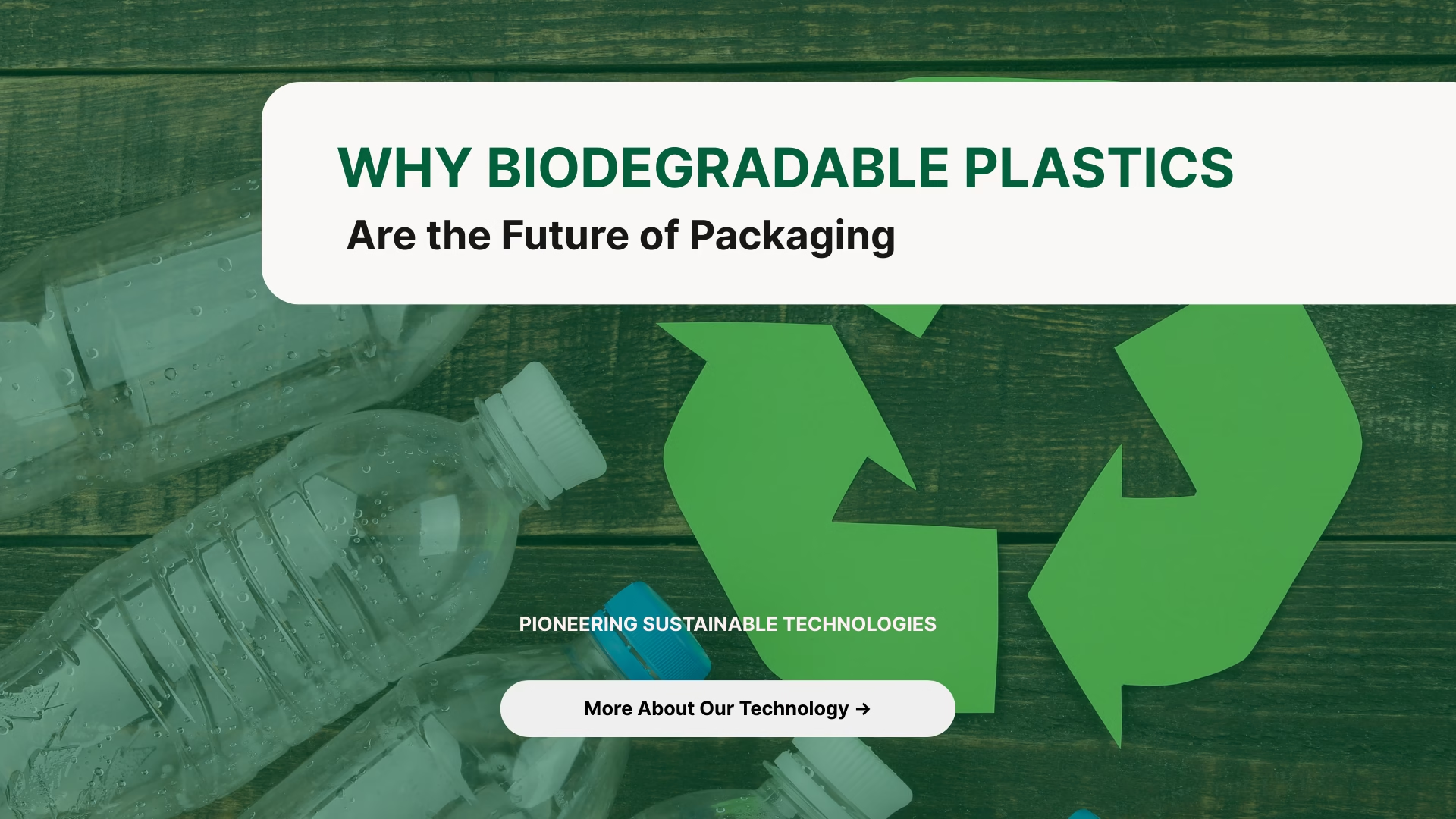Traditional plastics persist for centuries, leaving behind microplastics and toxic residue. Biodegradable plastics offer a cleaner, safer alternative that breaks down naturally without harming the environment or human health.
The Problem with Traditional Plastics
For decades, traditional plastics such as polyethylene terephthalate (PET), polyvinyl chloride (PVC), and polystyrene have dominated packaging due to their durability and low cost. However, these materials come with a hidden price tag:
- They take hundreds to thousands of years to degrade.
- They break down into microplastics, which enter food, water, and even the human body.
- They release toxic chemicals during decomposition.
- They contribute to massive pollution in oceans, landfills, and air.
A recent study from the National Institute of Health (NIH) found that a single litre of bottled water contains approximately 240,000 plastic particles, with 90% classified as nanoplastics—tiny enough to cross into the bloodstream, brain tissue, and even reach a developing foetus.
This growing awareness has led scientists, governments, and consumers to demand better alternatives—and biodegradable plastics are emerging as the most viable solution.
What Makes Biodegradable Plastics Different?
Unlike conventional plastics that fragment into harmful nanoplastics, biodegradable plastics use an enzyme-assisted breakdown process known as depolymerisation.
This technology introduces an organic additive during manufacturing, making the plastic attractive to microbes. When discarded in landfill, naturally occurring bacteria begin digesting the material. Enzymes secreted by these microbes break down the carbon bonds within the plastic molecules, transforming them into natural fertiliser rather than microplastics or toxic waste.
This closed-loop system ensures that packaging can be used safely and then fully returned to the environment—without long-term harm.
The Environmental Benefits of Biodegradable Packaging
The environmental impact of adopting biodegradable plastics is profound:
- Zero Microplastic Release: Unlike traditional plastics, biodegradable versions fully break down without leaving behind harmful nanoplastics.
- No Toxic Residue: The depolymerisation process leaves only natural biomass, supporting soil health instead of contaminating it.
- Reduced Landfill Burden: Biodegradable plastics significantly reduce persistent waste in landfills and prevent long-term ecological damage.
- Ocean Safety: If accidentally released into marine environments, biodegradable plastics do not accumulate like conventional ones—they break down naturally.
- Support for Circular Economy Models: These materials align with circular economy principles by returning to nature after use, reducing the need for new plastic production.
With global plastic production expected to triple by 2050, the urgency for sustainable alternatives has never been greater.
Real-World Applications Across Industries
Biodegradable plastic technology is already being adopted across multiple sectors:
Consumer Goods
Major brands are replacing PET bottles with biodegradable alternatives for shampoo, cleaning products, and beverages. This shift helps reduce nanoplastic contamination while maintaining product integrity.
Retail & E-commerce
Retailers are increasingly using biodegradable films and wraps for shipping and packaging. This change reduces reliance on synthetic plastics while meeting consumer demand for sustainable options.
Agriculture
Farmers are adopting biodegradable mulch films and packaging that decompose naturally after use, eliminating the need for costly and environmentally harmful removal processes.
Food Industry
Restaurants and food producers are switching to biodegradable containers made from enzyme-infused HDPE and LDPE, ensuring safe, sustainable packaging that doesn’t pollute our bodies or the planet.
These real-world applications show that biodegradable plastic is not just a theoretical concept—it’s a practical, scalable solution already making a measurable impact.
Public Health Implications
Beyond environmental benefits, biodegradable plastics also protect public health. Recent findings published in the New England Journal of Medicine revealed that microplastics are now embedded in human artery walls—patients with detectable plastic were 4.5 times more likely to suffer heart attacks, strokes, or die within three years.
This shocking discovery confirms what many scientists have long suspected: plastic pollution isn’t just an environmental crisis—it’s a public health emergency.
By replacing traditional plastics with biodegradable alternatives, we can reduce exposure to nanoplastics and mitigate long-term health risks—including DNA damage, hormone disruption, and immune system stress.
The Role of The Greener Tech Group
At the forefront of this movement is The Greener Technology Group, which is actively bringing verified, scalable, and scientifically backed biodegradable solutions to market.
Through strategic partnerships and import/export licensing, the group supports manufacturers in transitioning to biodegradable HDPE and LDPE under strict quality controls. It also plays a key role in educating businesses and consumers about the benefits of enzyme-assisted plastics, helping industries adopt greener alternatives without compromising functionality or safety.
One of its flagship innovations is the Eco Bottle, Australia’s first and only 100% biodegradable, reusable, and microplastic-free bottled water solution.
How Biodegradable Plastic Works: A Quick Recap
Here’s how the process works:
- Manufacturing Stage: An organic additive is introduced during production, making the plastic attractive to microbes.
- Post-Use Disposal: When discarded in landfill, microbes recognise the plastic as a food source.
- Microbial Digestion: Bacteria secrete enzymes that break down the plastic through depolymerisation.
- Full Breakdown: The plastic transforms into natural biomass, carbon dioxide, and water—leaving no microplastics behind.
This innovative approach ensures that packaging fulfils its function and then disappears safely—without lingering in the environment or entering the human body.
Why Businesses Should Make the Switch
Switching to biodegradable plastics offers several advantages:
- Reduces Long-Term Pollution: Eliminates persistent plastic waste that harms ecosystems.
- Protects Human Health: Prevents nanoplastics from entering the bloodstream and organs.
- Meets New Regulatory Standards: Aligns with evolving international policies on plastic waste and chemical exposure.
- Builds Brand Trust: Consumers are increasingly demanding eco-conscious products—adopting biodegradable packaging builds loyalty and credibility.
- Supports Global Sustainability Goals: Helps nations meet climate commitments and reduce dependence on virgin plastics.
As awareness grows, so too does the pressure on companies to act. With proven technology available today, there’s no reason to delay the transition to safer, sustainable packaging.
Conclusion: The End of Plastic Waste Is Within Reach
Biodegradable plastics represent a major breakthrough in sustainability science. By enabling full microbial digestion through depolymerisation, they provide a realistic alternative to the environmental and health hazards posed by traditional plastics.
With companies like The Greener Tech Group leading the way, biodegradable plastic is proving to be a powerful tool in the fight against plastic pollution.
We’re no longer limited to recycling or reducing plastic use—we now have the ability to eliminate plastic waste at the end of its life cycle. And with continued innovation and education, we can shift towards a future where plastic doesn’t mean permanent pollution.
Key Summary
✓ Biodegradable plastics break down through depolymerisation, allowing microbes to fully digest them without microplastics.
✓ Traditional plastic releases up to 240,000 particles per litre of bottled water, mostly nanoplastics that enter the bloodstream.
✓ Patients with microplastics in arteries face 4.5x higher risk of heart attack, stroke, or death within three years.
✓ The Greener Technology Group leads the shift by offering verified biodegradable HDPE/LDPE packaging and hydration solutions.
✓ Biodegradable plastics support public health protection, environmental regeneration, and global sustainability goals.
✓ This technology enables a closed-loop system, returning all components safely to the environment after use.

